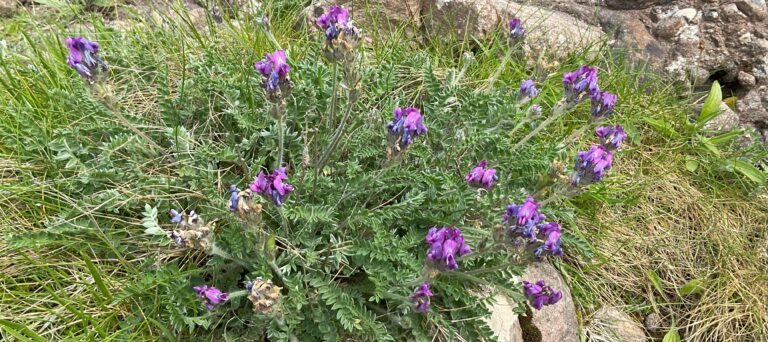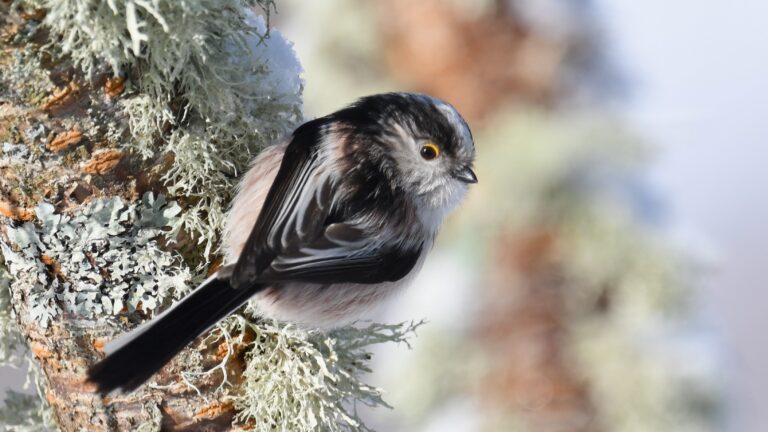
Primula scotica
Gaelic: Sōbhrach-Albannach
By Sarah Bird, Project Officer, Species on the Edge – North Scotland Coast, working for Plantlife

The Scottish Primrose season is here again – our most special wildflower is in the middle of the second flowering period in August, so now is a good time to look for them. Remember that it ONLY grows on our north coast, and on Orkney, and nowhere else in the world. In a way it ‘belongs’ to Scotland’s north coast communities – it is ours to love, protect and nurture. Any plant or animal that is only found in one small region is at risk of extinction. This is particularly true for Scottish Primrose because it is fussy and only grows in places where it finds the special conditions it needs. Research has shown that its genetics adds to the fragility of this plant.
Scottish Primrose is a north coast priority species for Species on the Edge, and I’m going to be out doing primrose surveys for most of August. Ideally we need to check all the places where it grows on the north coast, to help us to see if the Scottish Primrose numbers are stable, increasing or decreasing. The same is happening on Orkney to give a clear picture of how the whole population of this special plant is faring. I would love to hear where you have seen Scottish Primroses so do please send in your records via the Facebook group or here, If you would like to help with Scottish Primrose surveys over the next couple of years please do get in touch: Sarah.bird@plantlife.org.uk.
Where to look:
Most Scottish Primrose sites are within a few hundred metres of the sea, in open areas where vegetation is sparse and low. They are found in three main habitat types:
- on cliffs and rocky areas, from just beyond the sea spray zone up to cliff tops, where the turf is short and there is some bare ground, especially in wet areas that slope down towards the shore. Example: Cliffs at Strathy Point.
- on sand dunes in short turf, behind the area of loose sand and dune grasses. Example: Invernaver sand dunes.
- in damp heath pasture – some of these sites are further from the coast. Example: Burn of Midsands Coronation Meadow, Dunnet Bay.



When to look:
Scottish Primrose has two flowering times each year: in spring (usually May) and summer (usually July to August), though not every plant will flower in spring and summer. In a good year a plant may have more than one flower stem in the summer. so look out for flowers and seed heads on the same plant . There is usually a break in flowering in June. However, plants are affected by conditions each year so flowering time can vary – I have seen flowers from April through to October. I even saw one in November last year!
Studies by Elaine Bullard on Orkney in the 1980’s found that mild winters and warm weather in May increased the number of Scottish Primrose flowers, but that snowy winters lead to fewer flowers the following season. 2023/24 was a snowy winter but we did have warm weather in May, so this year could go either way. So far i’ve seen quite a lot of flowers, so i’m optimistic!
What to look out for:
Scottish Primrose is tiny – only a few centimetres tall- with grey-green stems and leaves, and striking bright pink flowers. If you haven’t seen them before you will be surprised by the intense flower colour, it really takes your breath away. Its easy to spot people looking at these plants – they are always crouched down staring at the ground!

Scottish Primrose leaves
The leaf colour makes them stand out from most other plants. I have been confused by leaves of daisies which are similar in size, but brighter green. The leaves form a rosette which is often less than 5cm across.


Scottish Primrose flowers
Flowers have five pinkish-purple heart-shaped petals and a yellow centre; the petals can turn darker bluish-purple as they age. Each flower stem carries a cluster of flowers called an umbel. The flowers are like garden primula flowers but MUCH smaller – less than 1cm across.


Scottish Primrose flowers all have the same structure (called homostyly), unlike Common Primrose and Cowslip which have two different types of flower (called heterostyly). Heterostyly is an adaptation to prevent seeds forming from self-fertilisation, to keep plant populations genetically diverse and therefore better able to cope with changes in climate and environment. A pollinator is needed to move pollen from one flower type to the other. You can find out more about heterostyly in common primrose and cowslip here.
Inside the flower
As a result of homostyly, Scottish Primrose flowers often fertilise themselves without needing insects. The pollen from the anthers grows on the stigma in the same flower and produces seeds.

This might be a good plan when pollinating insects are scarce, but it means that the new plants from these seeds are genetically identical to the parent. Scientists have detected that a few Scottish primrose flowers do get pollinated by insects (hoverflies and solitary bees), but this doesn’t happen often. It is likely that cross-pollination by insects may result in more vigorous plants that live longer. Detailed studies, once again by Elaine Bullard on Orkney, found some ‘super-plants’ like this, which flowered frequently and survived for 6-9 years on average.
Why is it rare?
Inevitably, a plant that is only found in one small region is at risk from extinction. We know that Scottish Primrose is fussy and isn’t able to compete with the taller plants. To flourish, Scottish Primroses need very short grass created by wind exposure or by grazing animals. Grazing by sheep and rabbits can be really important to allow the primroses to grow without being smothered by taller vegetation, and some bare earth in footprints, and around pools, rocks and paths allows seeds to grow. However, careful grazing management is vital between May and August to allow the primroses to flower and set seed. Over-grazing can be as damaging as under-grazing. Putting fertiliser on fields also encourages vigorous plants which crowd out Scottish Primroses.
Genetics
Studies at molecular level show that there is an almost complete absence of genetic diversity between individuals either within or between populations of Scottish primrose, even in very large populations like those at Sandside and Strathy Point. This is not a surprise when we know the flowers usually fertilise themselves, and produce seedlings that are genetically the same as the parent.
This means the species may be unable to respond to environmental change and is only likely to survive in places where conditions remain suitable – places where it is currently found, and which it seems to be well adapted to. A better understanding of detailed habitat requitements and protection of existing sites is vital for Scottish primrose to survive for the foreseeable future.
An idea for the future?
Some experts have suggested that an intensive cultivation project, deliberately cross-pollinating flowers and saving seed, then planting these seedlings into the wild might be a way forward in future.
References
Ritchie, J.C. ( 1954) Primula scotica. Journal of Ecology Vol. 42, No. 2. pp. 623-628
Bullard, E.R., Shearer, H.D.H., Day, J.D., Crawford, R.M.M. (1987) Survival and Flowering of Primula scotica. Journal of Ecology Vol. 75, No. 3. pp. 589-602
Glover, B.J., Abbott, R.J. (1994) Low Genetic Diversity in the Scottish endemic Primula scotica. New Phytologist Vol 129, pp. 147-153
I have copies of these papers, so please email me if you would like to read them and can’t access online. Sarah.bird@plantlife.org.uk.
,






